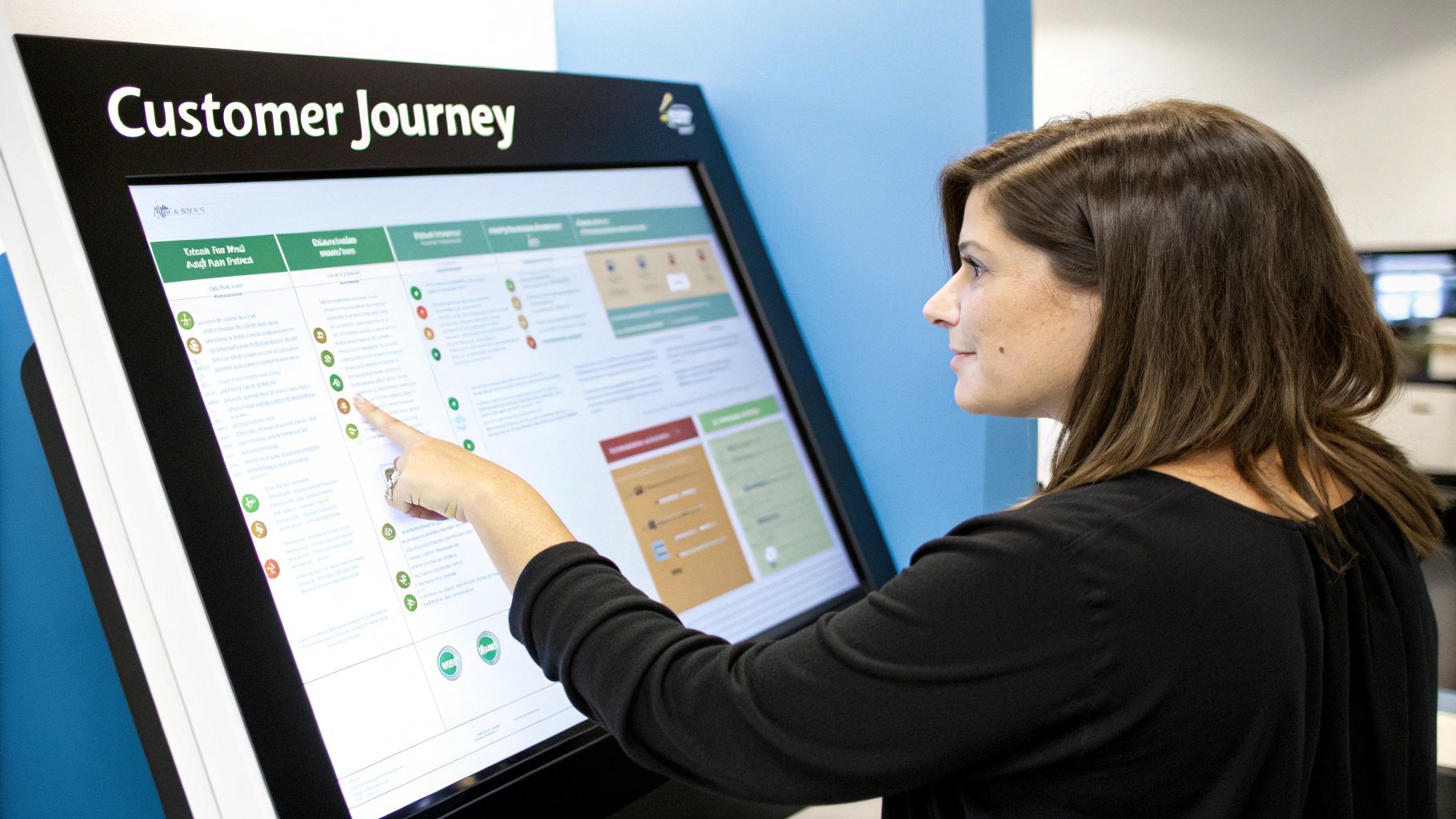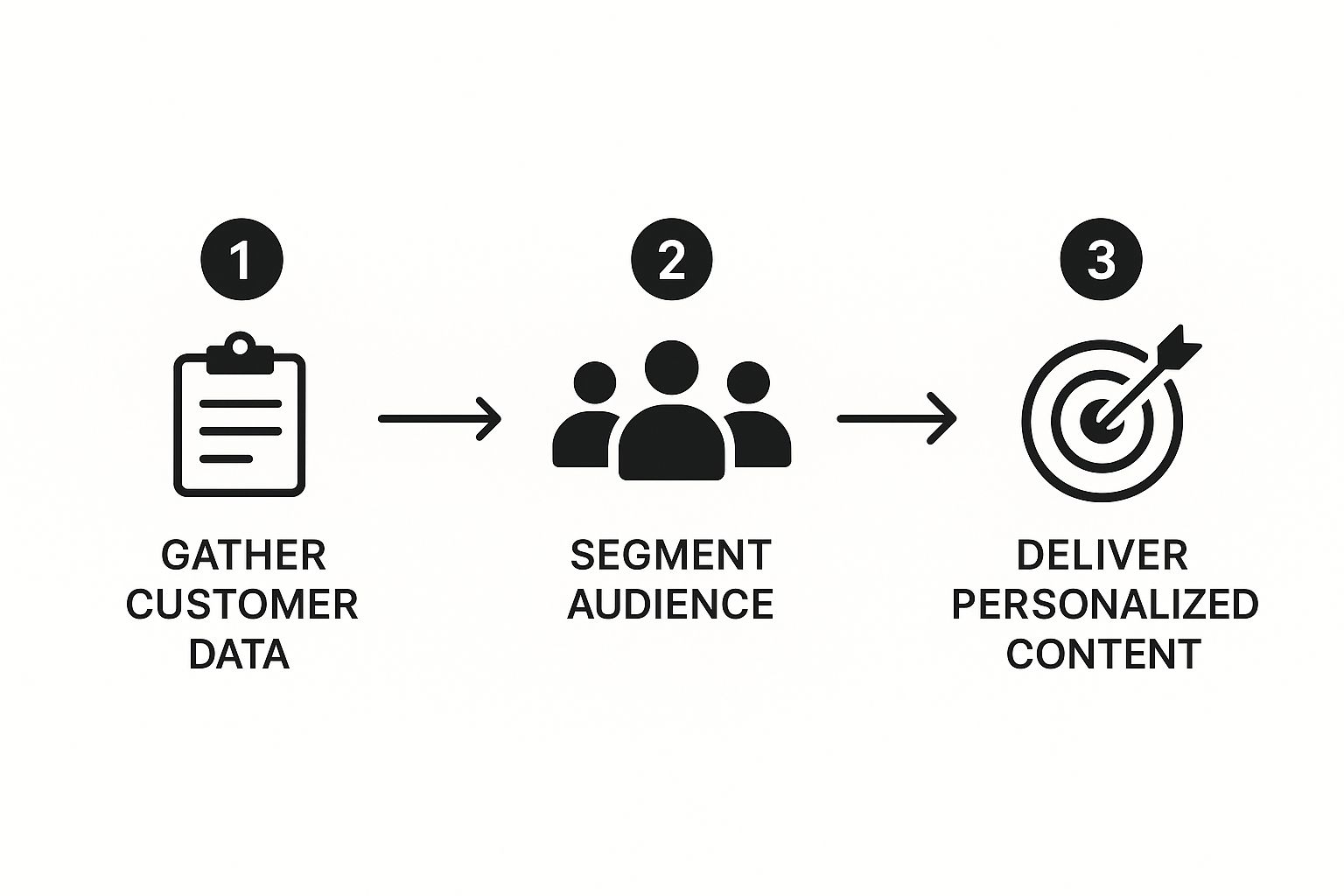So, what do we actually mean when we talk about “customer experience optimization”? It’s one of those terms that gets thrown around a lot, but the reality behind it is pretty straightforward.
Think of it less as a complex business theory and more as a fundamental commitment. It’s the continuous work of fine-tuning every single interaction a customer has with your company to make sure it’s not just good, but genuinely positive and memorable.
I like to compare it to a symphony orchestra. Your website is the string section, your support team is the woodwinds, your marketing emails are the brass, and the product itself is the percussion. If one instrument is out of tune or off-beat, the whole performance feels wrong. Customer experience optimization is the conductor’s job: ensuring every piece works in harmony to create something beautiful and cohesive.
Get it right, and the customer’s journey feels so effortless that they don’t just buy from you—they become genuine fans.
Why Exceeding Expectations Is the New Bare Minimum
In the past, meeting customer expectations was enough. A customer had a problem, you solved it. Job done. But today, that’s just table stakes.
The market has shifted dramatically. A superior experience isn’t a nice-to-have anymore; it’s a primary reason why people choose one brand over another. In fact, a staggering 70% of customers now make buying decisions based on the quality of the experience they expect to receive. That’s a massive change in consumer behavior. You can dive deeper into the drivers behind this shift in these global CX insights.
This means businesses can no longer afford to be reactive. We have to anticipate what customers need and deliver it before they even have to ask.
What Goes Into a Strong CX Strategy?
A truly effective CX strategy isn’t just a single project; it’s built on a few core pillars that work together. When you get these right, you start moving your customer relationships from purely transactional to something much deeper and more valuable.
Let’s break down these foundational components.
| The Core Pillars of CX Optimization | ||
|---|---|---|
| Pillar | Description | Key Business Impact |
| Customer Journey Mapping | Visually outlining every touchpoint a customer has with your business, from first awareness to post-purchase support. | Identifies friction points and reveals hidden opportunities to create “wow” moments. |
| Systematic Feedback | Actively collecting customer opinions through surveys (NPS, CSAT), reviews, and direct conversations. It’s about listening, not just hearing. | Provides the hard data needed to stop guessing and start making informed, customer-centric decisions. |
| Meaningful Personalization | Using what you know about a customer to tailor their experience—think relevant recommendations, not just using their first name in an email. | Makes customers feel understood and valued as individuals, which builds incredible loyalty. |
| Omnichannel Consistency | Ensuring a smooth, unified brand experience whether a customer is on your website, mobile app, social media, or talking to a support agent. | Builds trust and reliability. Customers know what to expect, no matter how they interact with you. |
Putting these pillars into practice is what separates the brands people tolerate from the brands people love.
Ultimately, optimizing the customer experience isn’t just about making people happy. It’s a direct investment in your bottom line. It boosts satisfaction, slashes customer churn, and builds a competitive advantage that’s incredibly difficult for anyone else to copy. It’s the engine that powers modern, sustainable growth.
Building an Unforgettable Customer Experience

A fantastic customer experience rarely happens by accident. It’s the result of careful planning, smart design, and a genuine understanding of what your customers actually need and want.
Think of it like building a custom home. You wouldn’t just show up and start laying bricks without a solid plan. You need a foundation, a detailed blueprint, and a clear vision for how every single room will be used and enjoyed.
In the world of customer experience, your data is the foundation. Your feedback loop is the architectural blueprint. And each personalized touchpoint is a thoughtfully designed room. When these elements work together, you create an experience that isn’t just functional—it’s a place customers are happy to return to, again and again.
Laying the Foundation with Journey Mapping
Before you can improve the customer journey, you have to see the whole picture. This is where customer journey mapping comes into play. It’s the process of visually outlining every single interaction a customer has with your business, from the first time they hear your name to the support they receive long after a purchase.
But a journey map is much more than a simple flowchart. It’s an exercise in empathy. It forces you to step out of your internal perspective and walk a mile in your customer’s shoes.
This process almost always uncovers critical insights:
- Pinpoint Friction: You can see exactly where customers get stuck or frustrated. Maybe it’s a confusing checkout page, a painfully slow support response, or a disconnect between your website and your app.
- Discover “Wow” Moments: Journey mapping also shines a light on opportunities to surprise and delight your customers, turning a routine interaction into something truly memorable.
A customer’s end-to-end journey is 30% to 40% more strongly correlated with customer satisfaction than any single touchpoint. Focusing on the entire experience, not just isolated moments, delivers far better business outcomes.
This map becomes the bedrock of your entire customer experience strategy, guiding every decision you make from here on out.
Constructing the Framework with Feedback
With your journey mapped out, the next step is to build a solid framework for gathering and—more importantly—acting on customer feedback. A blueprint is useless if the construction crew never looks at it. In the same way, a journey map is just a pretty document without a constant stream of real-world input to keep it relevant.
An effective feedback loop is about more than sending out the occasional satisfaction survey. It means creating a system where customer input is actively collected, analyzed, and woven into your daily operations. This is about unifying data from all your different channels to get a complete, 360-degree view of what customers are thinking and doing.
When done right, this unified view becomes your single source of truth for effective customer data management, helping you make decisions with confidence.
Here’s the rub: this is where many businesses get tripped up. The global market for customer experience software is projected to hit $11.6 billion by 2026. Yet, a staggering 70% of marketing leaders admit they struggle with disconnected data, which completely kneecaps their ability to create personal, relevant experiences. Getting your data unified is the key to empowering both your people and your systems to deliver service that truly connects.
How to Measure What Truly Matters in CX

Investing in customer experience optimization just feels right, doesn’t it? But feelings don’t convince stakeholders or prove your strategy is working. Without clear metrics, you’re essentially just guessing, hoping your efforts land. To get real results, you have to move from abstract goals to hard numbers that tell you what actually matters to your customers—and your bottom line.
This isn’t about collecting data for the sake of it. Think of CX metrics as your company’s health monitors. They’re the vital signs that show where you’re strong, where you need to improve, and whether your strategic treatments are having the desired effect. They turn the complex story of your customer’s journey into something you can track, understand, and act on.
The Big Three CX Metrics
While you could track countless data points, most successful CX strategies are built on a solid foundation of three core metrics. Each one answers a different, crucial question about how customers see your brand. Knowing when to use which one is the key to turning raw data into powerful insights.
Let’s break down the essential trio:
- Customer Satisfaction (CSAT): This is your in-the-moment happiness check. CSAT measures satisfaction with a specific interaction, like a support call or a recent purchase. You get this by asking a simple question like, “How satisfied were you with your experience today?” It’s an immediate pulse check on individual touchpoints.
- Net Promoter Score (NPS): NPS looks at the bigger picture: long-term loyalty. It gauges a customer’s willingness to stick with you and recommend your brand to others. The classic question, “How likely are you to recommend us to a friend or colleague?” on a 0-10 scale sorts your customers into Promoters, Passives, and Detractors.
- Customer Effort Score (CES): This metric gets right to the heart of friction. CES measures how easy it was for a customer to get something done, like resolving an issue or finding information. Asking, “How much effort did you have to put in to handle your request?” helps you pinpoint and smooth out frustrating parts of your process. And make no mistake, reducing effort is a massive driver of loyalty.
Here’s a sobering thought: research shows 91% of unhappy customers will just walk away without a word of complaint. This makes proactively measuring things with NPS and CES not just a nice-to-have, but an essential survival tool. You can’t fix problems you don’t even know you have.
Choosing the Right Metric for the Right Goal
These metrics aren’t interchangeable. Using the wrong one is like using a hammer to turn a screw—you might make a mark, but you won’t get the job done right. The trick is to match the metric to your specific goal. For example, trying to judge a single support interaction with a broad loyalty metric like NPS will give you fuzzy, unhelpful feedback.
To make it easier, here’s a quick guide on which metric to use and when.
Choosing the Right CX Metric for Your Goal
| Metric | Answers the Question… | Best Used For |
|---|---|---|
| Customer Satisfaction (CSAT) | “Is the customer happy with this specific interaction right now?” | Measuring the quality of individual touchpoints, like after a support ticket is closed, a purchase is completed, or a new feature is used. |
| Net Promoter Score (NPS) | “How likely is this customer to advocate for us and stay loyal over time?” | Gauging overall brand health and customer loyalty. It’s best used for periodic relationship check-ins, such as quarterly or annually. |
| Customer Effort Score (CES) | “How easy did we make it for the customer to achieve their goal?” | Identifying and eliminating friction in specific processes, like resolving a support issue, finding information on your website, or completing a return. |
By strategically deploying CSAT, NPS, and CES, you build a comprehensive picture of your customer experience. This data-driven approach is how you prove the ROI of your customer experience optimization efforts, guide your next moves, and ultimately, build a business that customers genuinely want to stick with.
Your Step-By-Step Guide to Optimizing the Customer Journey
Moving your customer experience from a nice idea on a whiteboard to a genuine, working reality takes a clear, repeatable process. This isn’t about making massive, disruptive changes overnight. It’s about being methodical—mapping, analyzing, and then improving each step your customer takes.
Think of yourself as a detective. You wouldn’t just guess who the culprit is; you’d gather clues, follow leads, and build your case piece by piece. Applying that same mindset to customer experience optimization means your changes will be grounded in solid evidence, not just a hunch about what your customers might want.
Step 1: Map the Current Customer Journey
Before you can improve anything, you need a brutally honest picture of how things work right now. Customer journey mapping is that crucial first step. It’s about creating a visual story of every single interaction a customer has with your business, from their first Google search to their tenth support ticket.
This isn’t just a flowchart of clicks. A good map digs into what the customer is doing, thinking, and feeling at every stage. You’ll almost always uncover some surprising pain points—a clunky checkout flow, an agonizingly long wait for a support reply, or wildly different messaging between your website and your app.
A common trap is mapping the journey you want customers to take. The real gold is in mapping the messy, winding paths they actually follow, using real data and direct feedback.
Step 2: Pinpoint Friction and Opportunities
With your map laid out, it’s time to put on your analyst hat. You’re looking for two specific things: points of friction and moments of opportunity. Friction is anything that slows a customer down or causes frustration. Opportunities are those little moments where you can deliver a bit of unexpected delight.
Look for places that demand high customer effort. For instance:
- Repetitive Information: Does a customer have to type their name and address into three different forms? That’s a classic sign of disconnected systems and a major annoyance.
- Dead Ends: Are there spots where people get stuck, like a 404 page that offers no help or a feature that just doesn’t work?
- Long Wait Times: Whether it’s a slow-loading page or a day-long wait for an email response, delays kill momentum and breed resentment.
At the same time, keep an eye out for places you can do more. Could a proactive chat pop-up help someone who seems stuck on the pricing page? Could you offer a genuinely useful, personalized recommendation after a purchase? These are the small, thoughtful touches that build real loyalty.
Step 3: Gather and Centralize Meaningful Feedback
Your journey map gives you a hypothesis. Direct customer feedback is what proves it. This is where you bring in metrics like CSAT and CES right at the touchpoints you’ve identified to see if your assumptions were correct.
But just collecting feedback isn’t enough—that’s only half the job. To be useful, it all has to live in one place. If your support tickets are in one system, survey results are in a spreadsheet, and web analytics are in a third platform, you can’t see the full picture. The most powerful strategies are always built on a unified view of the customer.
This simple infographic illustrates the basic loop of a data-driven personalization strategy.

As you can see, effective personalization isn’t a one-and-done task. It’s a continuous cycle of listening, understanding, and then responding in a meaningful way.
Step 4: Prioritize and Implement Changes
You’re going to end this process with a long list of potential fixes. Dozens, maybe even hundreds. If you try to tackle them all at once, you’ll get nowhere fast. The secret to actual progress is ruthless prioritization.
A simple but effective way to do this is with a priority matrix. Score each potential fix on two scales:
- Customer Impact: How much will this genuinely improve things for the customer? Is it a minor annoyance or a deal-breaker?
- Implementation Effort: How much time, money, and developer attention will this take?
Zero in on the high-impact, low-effort changes first. These are your “quick wins.” They build momentum and, just as importantly, they prove the value of your customer experience optimization efforts to the rest of the company. Rewriting a confusing help doc is a lot easier than redesigning an entire app, but it can still have a massive impact on a frustrated user.
Once you have your prioritized list, you get to work. Implement the change, measure the result, and start the cycle all over again. This loop—map, analyze, prioritize, implement—is the engine that drives continuous improvement.
How Operational Efficiency Impacts Customer Happiness

There’s a common myth floating around boardrooms that you have to choose between keeping operations lean and creating a great customer experience. The old thinking says that to be efficient, you have to cut corners, and to make customers happy, you have to spend a fortune.
That’s a false choice. In reality, operational excellence and customer happiness are two sides of the same coin.
The most powerful customer experience optimization strategies aren’t about throwing more money at the problem; they’re about making your internal engine run better. Think about it from your customer’s point of view. They don’t see your departmental budgets or internal workflows. They just want what they need, and they want it fast, without any hassle. A smooth, streamlined process is a better experience.
The Link Between Smooth Operations and Satisfied Customers
When you iron out a clunky internal process, you’re doing more than just saving a bit of time or money. You’re removing a point of friction that was directly impacting your customers. A faster shipping process means a customer gets their package sooner. A simpler return policy means less stress for someone who just bought the wrong size.
These aren’t just small wins. They’re the building blocks of perception and loyalty. Every moment a customer spends on hold, re-explaining their issue to another agent, or trying to figure out a confusing checkout process is a tiny crack forming in their relationship with your brand. Smoothing out these operational wrinkles is a direct investment in keeping your customers happy.
The trick is to look at every operational change through the eyes of your customer. Before you tweak a workflow to shave off a few dollars, ask one critical question:
Will this change make our customer’s life easier or harder? If the answer is “harder,” the long-term cost in lost loyalty will almost always wipe out any short-term savings.
Balancing Cost Savings and Customer Delight
Finding that sweet spot is where the magic happens. Take the airline industry, where a tiny operational tweak can have a massive financial impact. If an airline running 500 flights a day can cut boarding time by just one minute per flight, it could save around $5,475,000 a year. But if that new boarding process feels like a chaotic free-for-all for passengers, those savings get eaten up by bad reviews and unhappy flyers. You can dig into the research on this balancing act to see the numbers yourself.
This proves the goal isn’t just about being faster; it’s about being elegantly efficient. You need to build processes that both your CFO and your customers can get behind.
Here’s a simple framework to get started:
- Hunt for Friction: Use your customer feedback, support tickets, and journey maps to find the pain points. Where are things getting stuck? Onboarding? Billing? Tech support?
- Get Everyone in a Room: Your best ideas will come from mixing perspectives. Bring together people from operations, finance, and customer-facing teams to brainstorm solutions.
- Test and Measure: Don’t roll out a major change blindly. Pilot it with a small group of customers. Track the efficiency gains (time, cost) but also watch your CX metrics (like CSAT and CES) like a hawk.
By focusing on making your internal engine run more smoothly, you’ll naturally create a faster, more reliable, and more enjoyable ride for your customers. To get better at spotting these friction points, you might find our guide on the best customer experience mapping tools helpful.
Connecting HubSpot and Jira to Accelerate CX Wins
Modern customer experience optimization isn’t just a feel-good strategy; it’s built on smart technology that gets your teams talking. When your customer-facing folks are in one world and your tech teams are in another, even the best plans fall apart. The customer gets a clunky, disjointed experience, and your employees just get frustrated.
This is where the right integration stops being a simple tech add-on and becomes a real strategic advantage. When you connect your Customer Relationship Management (CRM) platform to your project management software, you create a powerful, closed-loop system. It’s a direct line from customer feedback to tangible product improvements.
Creating a Unified CX Engine
The link between a CRM like HubSpot and a project tool like Jira is a perfect example of this. HubSpot is the home for all your customer data—every contact, deal, and support ticket. Jira is where your developers and technical teams live, tracking bugs, planning new features, and managing project tasks.
Without a bridge, information gets lost in translation. A support agent might promise a customer a bug fix, but they have no simple way to see if the dev team is even looking at it. A salesperson might lose a deal over a missing product feature, but that critical feedback never finds its way to the people who build the product.
When customer-facing teams and development teams are disconnected, the customer is the one who pays the price. Integrating HubSpot and Jira demolishes these departmental silos, creating a single, transparent workflow centered on the customer.
This connection makes sure the customer’s voice isn’t just heard—it gets acted on, with everyone able to see what’s happening.
How the HubSpot-Jira Integration Works
Picture this very common scenario: a loyal customer hits up your support team through HubSpot to report a nasty bug in your software.
- The Ticket Arrives: The support agent logs the problem as a ticket in HubSpot, capturing all the customer’s details and a clear description of the issue.
- A Jira Issue is Born: Here’s the magic. Right from the HubSpot ticket, the agent can instantly create a linked Jira issue. All the crucial context—who the customer is, how valuable their account is, their history with you—is automatically bundled up and sent over to Jira.
- Developers Have Context: The dev team picks up the Jira issue. But instead of a generic bug report, they see the real person impacted by it. This is a game-changer for prioritization. Is this bug affecting a massive enterprise client? They’ll know immediately.
- The Loop is Closed: As developers work on a fix, their comments and status updates in Jira can be set to sync right back to the HubSpot ticket. Now, the support agent can see the progress in real-time without ever leaving their own workspace. Once the bug is squashed and deployed, the Jira issue is closed, which automatically updates the HubSpot ticket.
- A Proactive Follow-Up: The support agent gets a notification and can now proactively reach out to the customer with the good news. What started as a reactive support problem has just become a positive, proactive interaction that builds loyalty.
This screenshot shows exactly how HubSpot information gets embedded right inside a Jira issue, giving developers immediate access to the customer data they need.
This embedded view means developers aren’t wasting time hunting for information or jumping between tools. It dramatically speeds up their workflow and ensures customer context is never lost.
This two-way street of information is what makes the whole thing so powerful. It aligns your teams around one shared goal: solving customer problems, fast. By building this bridge, you can learn more about how a HubSpot Jira integration creates seamless workflows and transforms your support desk into a true engine for innovation and improved customer experience optimization.
Answering Your Questions About CX Optimization
When you’re first diving into customer experience optimization, a few common questions always pop up. How do you actually get started? What’s the real difference between this and just doing good customer service? It’s completely normal to have these questions.
Let’s walk through some of the most frequent hurdles. Getting these sorted out upfront helps you build a strategy on a solid foundation, not just on a pile of buzzwords.
What Is the Difference Between Customer Service and Customer Experience?
It’s incredibly common to hear these terms used interchangeably, but they’re fundamentally different concepts. Here’s a simple way to think about it:
- Customer Service is reactive. It’s one specific piece of the larger puzzle, focused on solving a problem in a single moment—like a support agent answering a question or a store employee processing a return.
- Customer Experience (CX) is proactive and holistic. It’s the entire puzzle. CX is the sum total of every interaction a customer has with your brand, from the very first ad they see to the usability of your website, the quality of your product, and the follow-up email they receive after a purchase.
Good customer service is a critical ingredient in a great customer experience, but it’s not the whole recipe.
How Often Should We Measure CX Metrics?
There’s no magic, one-size-fits-all answer here. The right cadence for measuring metrics like NPS or CSAT really depends on your business model and the specific part of the customer journey you want to understand.
For a transactional business like an e-commerce store, sending a CSAT survey right after a purchase or a support chat gives you priceless, in-the-moment feedback. But for a subscription-based software company, a quarterly or bi-annual NPS survey is a much better fit for gauging the overall health of the relationship and long-term loyalty.
The key is to be consistent and to tie your measurements directly to the journey stage you’re trying to improve.
The most effective measurement strategies don’t just collect data; they create a rhythm of listening. This rhythm allows you to spot trends over time, rather than just reacting to isolated feedback points.
Where Should We Start on a Small Budget?
You absolutely do not need a massive budget to kick off a customer experience optimization project. In fact, the smartest way to begin is to focus your resources where they’ll have the biggest impact.
Start small. Pick just one high-value customer journey to map out, like the new client onboarding process or your e-commerce checkout flow. You can use free tools like online surveys and even conduct a handful of quick customer interviews to find the single biggest point of friction.
Often, fixing one or two critical pain points—a confusing form, a broken link, an unclear instruction—delivers a huge return for a tiny initial investment. This builds momentum and makes the case for tackling bigger projects down the line.
Ready to connect your teams and turn customer feedback into real-time action? resolution Reichert Network Solutions GmbH‘s HubSpot for Jira app creates a seamless bridge between your CRM and development workflows. See how you can accelerate your CX wins.
